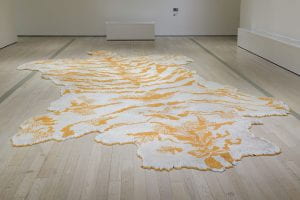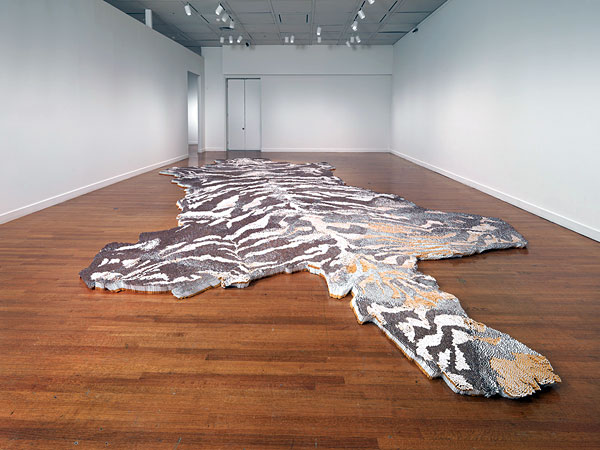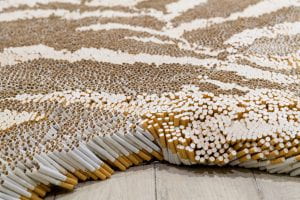Xu Bing is a modern artist who specializes in full room-scale installations, as well as art books. He created a sort of script he calls ‘Square Word Calligraphy’ that allows Latin letters to be used in traditional Chinese character form, like the font of the title of his official website:

This exhibition will mainly feature “1st Class” a massive model tiger skin rug made from stacked and arranged ‘1st Class’ brand cigarettes, the cheapest brand available in China. I will also showcase Xu Bing’s “Poem Stone Chairs” that form an ancient poem called “Reflections While Reading” by Zhu Xi (Southern Song Dynasty). “A small square pond, an uncovered mirror where sunlight and clouds linger and leave. I asked how it stays so clear. It said spring water keeps flowing in.” He writes this poem in his square calligraphy format. In my exhibit, people can sit on the poem stones that would surround the tiger skin rug. Including other works as well, my exhibit will explore Xu Bing’s recognition of Western culture influencing the arts and culture of modern China. The exhibit will mainly focus on the Tobacco Project and Xu Bing’s exploration of humanity’s relationship with tobacco and addiction, but it will also give context to his artistic prowess by highlighting some of his “Square Word Calligraphy” works.




 Xu Bing was born in Chongqing, in 1955 and grew up in Beijing. He went to the Central Academy of Fine Arts in Beijing in 1977, and went on to join the faculty and earned a master’s degree at the same school after completing his printmaking studies. In 1990 he was invited to the US as an honorary artist, and in 2007 he went back to China and was appointed multiple leadership roles at the Central Academy of Fine Arts, including supervisor of doctoral students, professor, and Vice President. Xu Bing creates all kinds of art from printmaking to large-scale room installations with an emphasis on using unique materials. Below is (the best close-up I could find of) a tiger rug made of cigarettes turned in two different directions, symbolizing humanities’ tendencies to fall into bad smoking habits. The ‘rug’ is made from over 500,000 individual cigarettes and weights more than 440lbs. Xu Bing has won numerous awards celebrating not only his artistic originality but also his transcendence of cultural boundaries, “bridging the divide between East and West and expressing his thoughts and realities in a visual language.” (quoted from the bio on his
Xu Bing was born in Chongqing, in 1955 and grew up in Beijing. He went to the Central Academy of Fine Arts in Beijing in 1977, and went on to join the faculty and earned a master’s degree at the same school after completing his printmaking studies. In 1990 he was invited to the US as an honorary artist, and in 2007 he went back to China and was appointed multiple leadership roles at the Central Academy of Fine Arts, including supervisor of doctoral students, professor, and Vice President. Xu Bing creates all kinds of art from printmaking to large-scale room installations with an emphasis on using unique materials. Below is (the best close-up I could find of) a tiger rug made of cigarettes turned in two different directions, symbolizing humanities’ tendencies to fall into bad smoking habits. The ‘rug’ is made from over 500,000 individual cigarettes and weights more than 440lbs. Xu Bing has won numerous awards celebrating not only his artistic originality but also his transcendence of cultural boundaries, “bridging the divide between East and West and expressing his thoughts and realities in a visual language.” (quoted from the bio on his 

